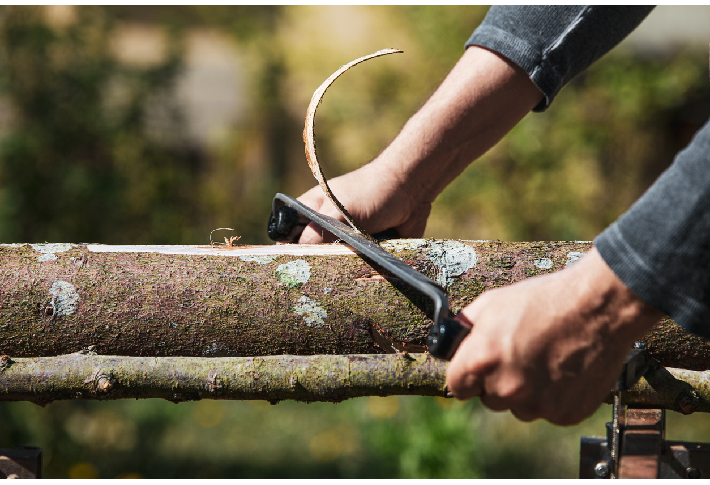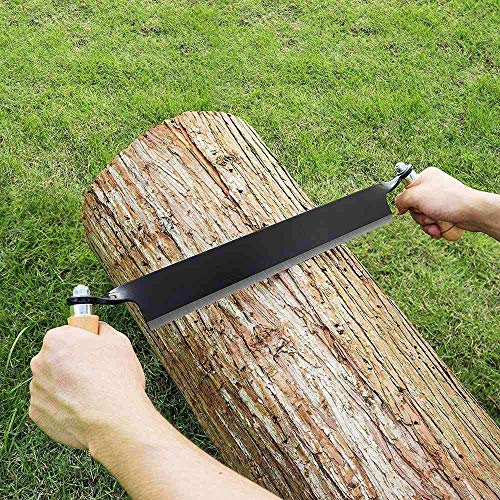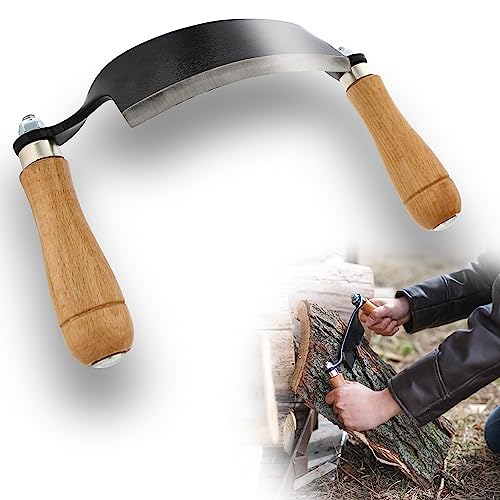The Best Draw Knife – A Must-Have Gadget In a Woodworker’s Toolbox

Our Top Picks
- Best Overall: Timber Tuff Straight Draw Knife Shop Now ➔
- Runner Up: Carmyra Draw Knife Shop Now ➔
- Honorable Mention: Felled Draw Knife Shop Now ➔
- Also Consider: Stubai Draw Knife Shop Now ➔
- Another Great Option: Flexcut Draw Knife Shop Now ➔
Compare The Best Draw Knives In 2024
Best Overall
The Timber Tuff TMB-ODS draw knife offers a stunning combination of features for its price. The blade length is 8 inches with 5mm of thickness paired with the hardness of HRC 30. These characteristics of the high-carbon stainless steel blade paired with the knife being angled at 30 degrees make the Timber Tuff draw knife an efficient tool to work with on both large and smaller wood pieces for carving and woodturning. The detachable, wooden handles provide a comfortable feel for the user. This knife also comes with blade protectors to ensure the safety of the user and the longevity of the blade sharpness. However, this blade needs to be sharpened right after unboxing and also often when in use.
Pros
- Affordable compared to other models
- Durable so it lasts for a long time
- Comfortable handles for a secure grip
Cons
- Needs to be sharpened often
Runner Up
If you are looking for a pocket-friendly yet efficient draw knife, this Carmyra pick is the ultimate choice. The blade is hard stainless steel with polished beveled edges. It has a length of 8 inches and thickness of 5mm. The knife is angled at 30 degrees with a hardness of HRC 30. This draw knife offers razor-sharp accuracy and works well even when exerted with great force. A secure hold is ensured by the sturdy, wooden handles and the light weight (1.7 pounds) of the drawknife. This knife also features a rubber edge protector to guarantee the user’s safety and to keep the blade sharp.
Pros
- Strong, durable blade
- Lightweight with wooden handles
- Comes with a blade protector
Cons
- Needs to be sharpened before the first use
Honorable Mention
The Felled draw knife is a compact but versatile tool with a 5-inch blade, 0.3 inches in thickness. The curved blade is made of hardened steel and refined beveled edges which offer wide applications of use from timber farming to furniture making. The big handle is made of wood to give the user a secure grip and protection from the blade. A rubber protective sheath comes with this knife to shield the blade from attrition and to keep the user safe. Only 1.3 pounds in weight, the Felled draw knife is easy to control and maneuver around for projects of all scales.
Pros
- Made of hard, durable steel
- Comfortable wooden handles
- Lightweight so it does not tire the user out
- 1 year manufacturer warranty
Cons
- Costly when compared to other models
- Blade not sharp enough
Also Consider
In any line of work, the quality of equipment is paramount to efficiency and the results produced. Therefore, if you are in search of a high-quality draw knife, this Stubai knife is just the one for you. Made from industry-grade steel sourced from Stubai, Austria, this knife is essentially straight with a slight curvature in its blade for maximum accuracy. The blade is 9.25 inches in length and 1 inch in width, which makes it a tad longer in size than a medium-sized draw knife. The handles are made of robust plastic with a rubber coating for an unshakeable hold. The handles may seem short at first glance but their offset angle provides the user just the right angle to make quick work of big pieces of wood.
Pros
- Made from high-quality steel
- Slightly curved blade
- Stays sharp for a long time
Cons
- Not suitable for smaller projects
Another Great Option
The Flexcut draw knife comes with the promise of simplicity and efficiency, and it delivers. This knife has a 5 inch flexible blade which adds to its ability to get into narrow corners and work with ease on concave or convex surfaces. The blade is mighty sharp, and hence, suitable for small to medium projects. Two ashwood handles at offset angles give the user more control and safety during use. However, there is a safety concern regarding the handles because they are not screwed in, only glued to the blade. This may lead to the handles breaking off unexpectedly. This draw knife also comes with a leather protective sheath.
Pros
- Flexible blade which adapts to the wood surface
- Ash hardwood handles
- Blade retains edge and sharpness
- Protective leather sheath included
Cons
- Handles are not durable and may loosen or come off
Best Draw Knives Buying Guide
Professional woodworkers already know the vital characteristics of a good draw knife and how to use and maintain it. However, for the newbies, it is imperative to reiterate these qualities so you make no mistake when you buy your first draw knife. Now that you know all about our top-rated picks, let us familiarize you with the qualities and features so you can pick a knife that works best for you.
What Is a Draw Knife and How To Use It?
A draw knife is a traditional hand tool with applications in the woodworking industry. From debarking logs to preparing timber, it serves its purpose by shaving off slices of wood.
It is a simple tool but has a complicated structure to aid its purpose. The blade has a varying thickness, with one side flat and the other beveled. The design of the blade may be straight or curved, each having its own merits. Two handles, generally made from wood or any other non-slip material, are attached to the ends of the blade. These handles are often angled towards the user.
The handles are held and pulled towards the user parallel to the wood surface, hence the name, draw knife. Never push the knife away as it can lead to an injury or the blade getting stuck in the wood. In case the blade is stuck, carefully coerce it out rather than chipping away at the wood or pulling back with force.
A pro tip is to consider the type of wood you are working with. Drier woods are easier to shave than timber that has moisture. The angle of the knife also depends on the hardness of the wood. For harder woods, use a draw knife angle at up to 35 degrees. On the other hand, draw knives angled at 2 degrees or less will be suitable for softer woods.
Safety is always a top concern when it comes to blades. The use of protective gear like gloves and eye goggles minimizes the risk of accidental cuts from wood shavings getting in your eyes.
For more tips on using a draw knife, check video from Hoffman Blacksmithing.

Sharpening and Maintenance of a Draw Knife
Sharpening
Like any other knife, a drawknife is of no use if it is not sharp. Working on rough and uneven surfaces like raw wood, a drawknife can get blunt quickly. Not only will this make the knife inefficient, but also be dangerous. However, sharpening it is no big hassle if you know how to do it. Here are the precise steps you can follow:
- Safety first – Precautionary measures are paramount when working with sharp blades. Wear your gloves and secure the draw knife tightly to avoid any unfortunate accidents.
- Secure the draw knife – There are two ways in which you can go about sharpening your knife. The first one is to secure one side of the knife against a wall or bench and the other side against your gut. The second method is to place the stone on a pedestal so that the handles of the drawknife go on either side with the blade right on top of the Waterstone.
- Sharpen your draw knife – You can either use sharpening stones or a machine. However, a stone is recommended because you can easily go wrong with a machine. Start off with sharpening the bevel side first then moving onto the flat side. Rub the stone in circular motions against the blade to sharpen it.
- Polish – Sharpening may lead to some scratches on your drawknife. So, for aesthetic purposes, you can use a smoother stone and do exactly as you did for sharpening for a shinier look.
Maintenance
A draw knife is not a very demanding tool. The key to its durability is to keep it sharpened. Other things you might want to do are oil the handles and keep the rubber/leather sheath on the blade so it does not lose its sharpness over time.
What Are the Uses of a Drawknife?
Draw knives are handy tools with an edged blade with a myriad of applications when it comes to woodwork. Here are some uses of their uses:
- Lathe work
- Stripping bark
- Debarking trees
- Preparing logs by hand
- Sculpting
- Chamfering edges
- Building furniture
- Building fences
What To Look For in a Quality Draw Knife?
Length of the blade
The length of the blade directly depends on the task at hand. A smaller blade is recommended for artistic, sculpting work as it provides maneuverability and precision. A larger blade, on the other hand, is best suited for preparing wood, like lathe work. A larger blade will be faster but difficult to control than a smaller blade. A medium-sized blade is best in terms of versatility.
The thickness of the blade
The perfect blade thickness minimizes material wastage and offers maximum strength. Too thick of a blade will make the process more complicated and lead to thicker shavings but a thinner blade is comparatively brittle.
Blade design
The blade design may be straight or curved. A straight blade is ideal for smooth cuts while a curved blade meanders into narrow spots and produces deeper cuts.
Handles
The handles of a drawknife are essential to the safety and control it offers a user. Sturdy and comfortable handles are the key to safe and long working hours without tiring the user. Draw knives may come with fixed or adjustable handles. While adjustable handles may seem like an intriguing choice, it is recommended to purchase a knife with fixed handles to ensure stability and protection. The material of the handles is equally important. Non-slip, solid handles with a cozy grip help the user work comfortably. Downward facing handles are also preferred because they reduce the amount of strength the user has to put in.
Sharpness
Being a cutting tool, a draw knife’s primary purpose is cutting and sharpness determines how well the knife cuts. Buy a knife that does not easily go blunt and has a prominent edge.
Support screws
Support screws secure the handle to the blade. If these screws are not properly fitted or get loose over time, it can lead to a serious injury. Some models of draw knives also have their handles glued on, with no screws. It is recommended to avoid buying these.
Verify the tightness of the support screws after unboxing a new drawknife and keep a keen eye on them throughout because heavy-duty work and pressure may loosen them.
Weight
More often than not, woodworkers work all day long. A heavy, bulky draw knife will slow the user down and tire them out soon. A good knife will weigh no more than 2 pounds.
Safety
Apart from caution by the user, there are two factors, equipment-wise that can add to safety. The first is the handles. A good, secure grip on the handles is essential so that the user does not tire out, is protected from accidental cuts and the drawknife does not slip away. The second is the protective sheath that may come with the knife. Go for a knife that includes a rubber or leather protective sheath for the blade to shield the blade and keep the user safe.
PEOPLE ALSO ASKED
Is the blade of poor quality if it is dull when it is delivered?
A lot of draw knives come with a dull blade that is sharpened later by the users. Some of them are purposefully left blunt as they are covered with a non-corrosive substance. However, this does not indicate poor quality. Quality depends on the longevity of sharpness.
Is a thin blade better than a thick one?
In most cases, yes. A thick blade will result in more material wastage and make the cutting process more difficult. However, too thin of a blade may be too fragile for thicker barks.
Are wooden handles better than urethane handles?
As much as you want it, there is no definitive answer to this. Both types have their merits. Even though wooden handles are non-slip, they may cause discomfort when compared to urethane handles when you are working for longer hours because they are softer. Urethan however is toxic if absorbed by the skin.
Article Contributors
The Woodsmith Review Team’s product reviews and in-depth guides are here to help you choose the best tools and gear to build great-looking projects confidently. Woodsmith is reader-supported: When you buy through links on our site, we may earn an affiliate commission. Large language models (like Artificial Intelligence) may have been used in the research and creation of the content.
Inquiries regarding specific articles or product testing should be sent to aimperiapt@gmail.com





